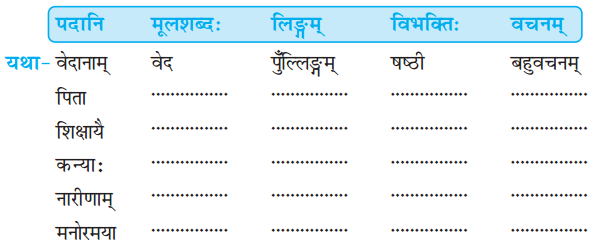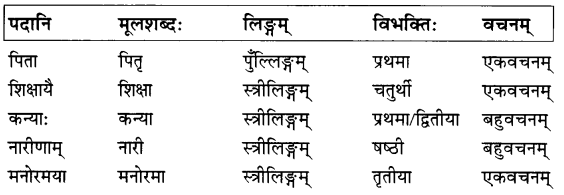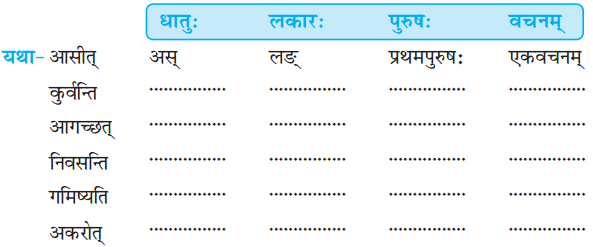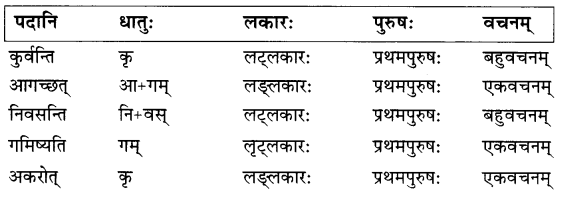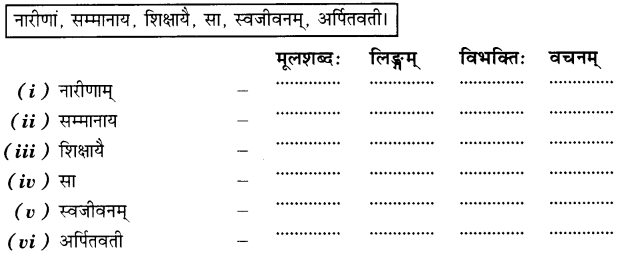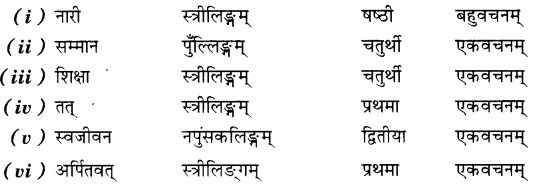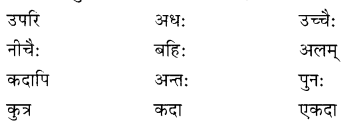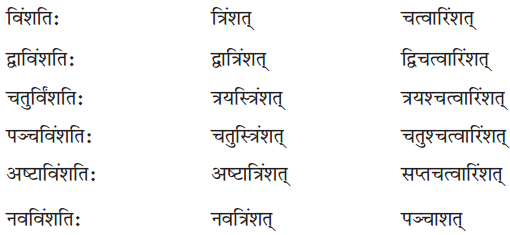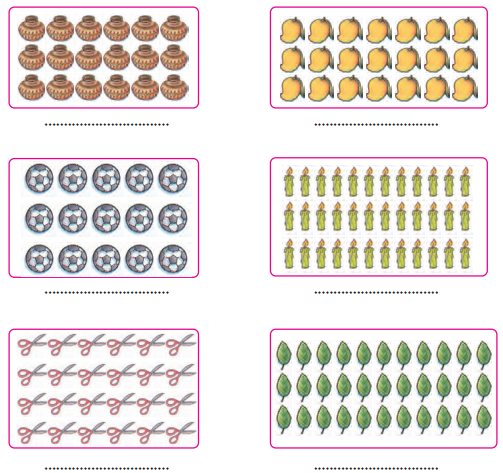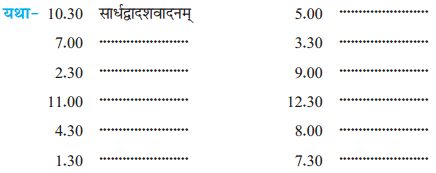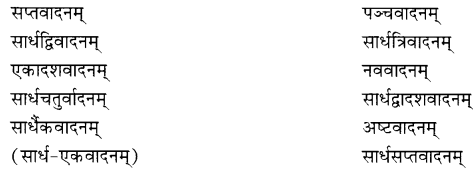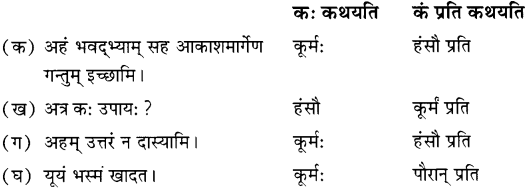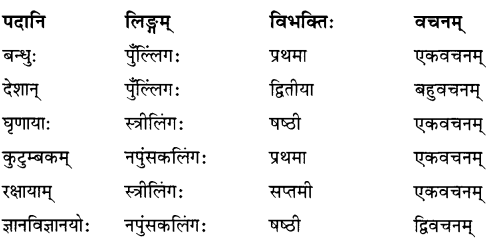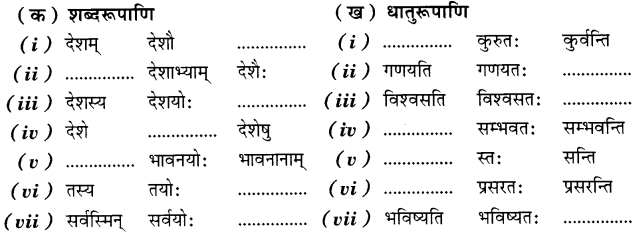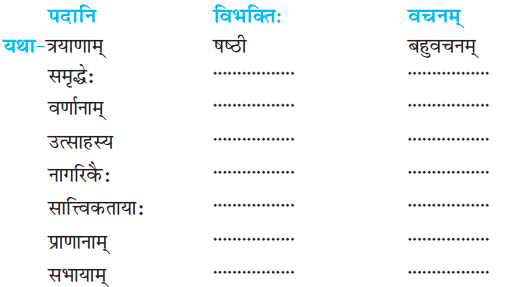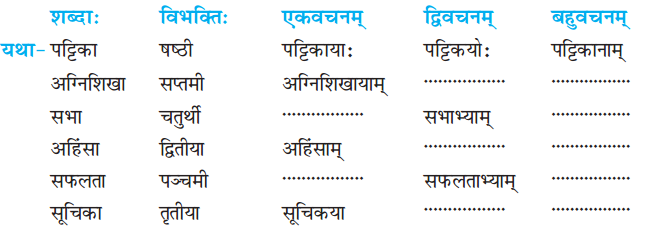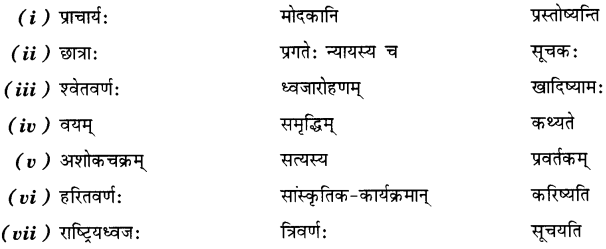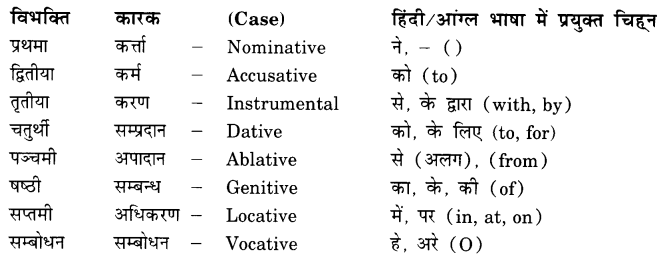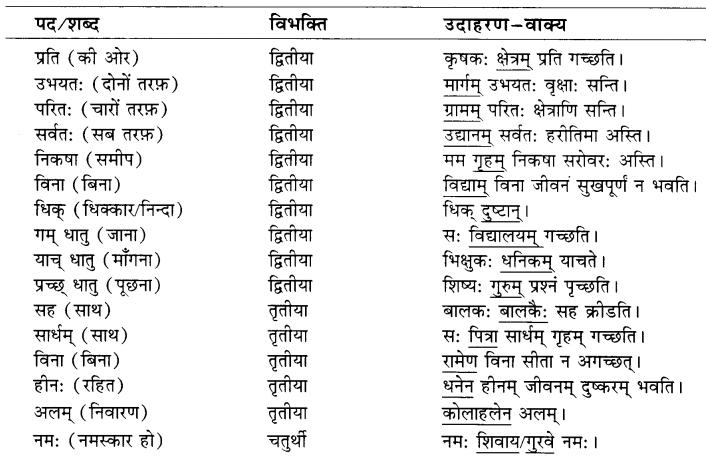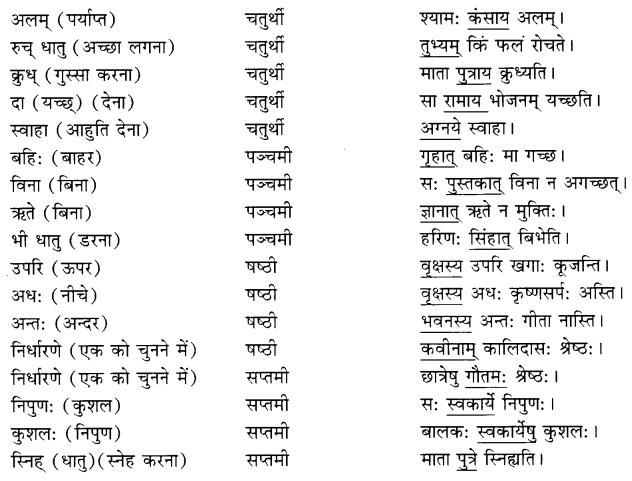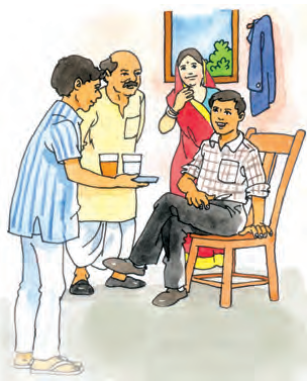We have given detailed NCERT Solutions for Class 7 Sanskrit Grammar Book शब्द-विचार: Questions and Answers come in handy for quickly completing your homework.
Sanskrit Vyakaran Class 7 Solutions शब्द-विचार:
हम सीख चुके हैं कि वर्गों के सार्थक मेल से शब्द बनते हैं। वाक्य में प्रयोग में आने वाले शब्दों को पद कहते हैं। यथा- ‘राम’ शब्द है; ‘रामः गच्छति’ वाक्य में ‘रामः’ पद है।
शब्द दो प्रकार के होते हैं।
- विकारी
- अविकारी
1. विकारी शब्द – इसके अन्तर्गत संज्ञा, सर्वनाम, विशेषण तथा क्रिया पद आते हैं। इन्हें विकारी (परिवर्तनशील) इसलिए कहते हैं क्योंकि वाक्य प्रयोग के समय इनमें विभक्ति, वचन, लिङ्ग आदि के कारण परिवर्तन (Change) आ जाता है।
संज्ञापद – रामः, लता, फल आदि
सर्वनामपद – तत्, एतत्, किम् आदि
विशेषणपद- विशाल, सुन्दर, दीर्घ, एक, द्वि, आदि
क्रियापद भी इसी श्रेणी में आते हैं। प्रत्येक क्रियापद धातु से बनता है। यथा गच्छति, अगच्छत्, गच्छतु, गमिष्यति आदि गम् धातु से बने हैं। क्रियापद में भी काल, पुरुष व वचन के कारण परिवर्तन (Change) आ जाता है।
2. अविकारी शब्द-वे शब्द जिनमें लिङ्ग, पुरुष, वचन, काल आदि के कारण कोई परिवर्तन नहीं आता है वे अविकारी शब्द कहलाते हैं। अव्यय पद- कुत्र, यत्र, तत्र, कदा, च, न इत्यादि इसी श्रेणी में आते हैं।
लिङ्ग (Gender) – संस्कृत भाषा में शब्दों को तीन लिङ्गों में विभक्त किया गया है-
(क) पुंल्लिङ्ग (Masculine Gender) – जिस शब्द से पुरुष जाति का बोध होता है, वह ‘पुंल्लिङ्ग’ कहलाता है; जैसे- बालकः, देवः, नरः, वानरः, खगः, अरुणः।
(ख) स्त्रीलिङ्ग (Feminine Gender) – जिस शब्द से स्त्री जाति का बोध होता है, वह ‘स्त्रीलिङ्ग’ कहलाता है; जैसे-बालिका, नदी, लता, चटका, रमा, मतिः, बुद्धिः आदि।
(ग) नपुंसकलिङ्ग (Neuter Gender) – जिन शब्दों से न पुरुष जाति अथवा न स्त्री जाति का बोध होता है, वे ‘नपुंसकलिङ्ग’ कहलाते हैं; जैसे- पुस्तकम्, फलम्, मित्रम्, पत्रम्, क्षेत्रम् आदि।
वचन (Number) – शब्द के जिस रूप से किसी वस्तु विशेष के एक या दो या अधिक होने का बोध होता है ‘वचन’ कहलाता हैं। संस्कृत भाषा में ‘वचन’ के तीन भेद हैं-
1. एकवचन (Singular) – एक वस्तु अथवा व्यक्ति का बोध कराता है- नरः, देवः, फलम्, बालकः, कन्या, लता आदि।
2. द्विवचन (Dual) – दो व्यक्तियों अथवा वस्तुओं का बोध कराता है-नरौ, देवौ, फले, बालकौ, कन्ये, लते आदि।
3. बहुवचन (Plural) – तीन या उससे अधिक के लिए-नराः, देवाः, फलानि, बालकाः, कन्याः, लता आदि।
संज्ञापद, सर्वनामपद तथा विशेषण पदों के अतिरिक्त क्रिया पदों में भी तीनों वचनों का प्रयोग होता है। यथा- पठति, पठतः, पठन्ति इत्यादि।
पुरुष (Person) – संस्कृत भाषा में पुरुष तीन होते हैं-
(क) प्रथम पुरुष (Third Person)
(ख) मध्यम पुरुष (Second Person)
(ग) उत्तम पुरुष (First Person)
(क) प्रथम पुरुष (Third Person) – जिसके विषय में बात की जाती है, वह ‘प्रथम पुरुष’ कहलाता है। संस्कृत भाषा में प्रथम पुरुष के तीनों लिङ्गों में भिन्न रूप होते हैं।
पुंल्लिङ्ग (Masculine) – सः (वह) – तौ (वे दोनों) – ते (वे सब)
स्त्रीलिङ्ग (Feminine) – सा (वह) – ते (वे दोनों) – ताः (वे सब)
नपुंसकलिङ्ग (Neuter) – तत् (वह) – ते (वे दोनों) – तानि (वे सब)
सर्वनाम के स्थान पर जातिवाचक अथवा व्यक्तिवाचक संज्ञा का प्रयोग भी प्रथम पुरुष में होता है। यथा-
पुंल्लिङ्ग (Masculine) – बालक: – बालको – बालकाः
स्त्रीलिङ्ग (Feminine) – बालिका – बालिके – बालिकाः
नपुंसकलिङ्ग (Neuter) – पुस्तकम् – पुस्तके – पुस्तकानि
(ख) मध्यम पुरुष (Second Person) – जिससे सीधी वार्ता होती है, अथवा बात करते समय जो हमारे सामने रहकर हमारी (वक्ता की) बातें सुनता है वह ‘मध्यम’ पुरुष कहलाता है। ये शब्द तीनों लिंगों में समान होते हैं।
त्वम् (तू/ तुम)
युवाम् (तुम दोनों)
यूयम् (तुम सब)
(ग) उत्तम पुरुष (First Person) – जिस शब्द को व्यक्ति या वक्ता स्वयं अपने लिए प्रयोग करता है, वह ‘उत्तम पुरुष’ कहलाता है। ये शब्द तीनों लिंगों में समान होते हैं।
अहम् (मैं)
आवाम् (हम दोनों)
वयम् (हम सब)
अभ्यासः
1. अधोदत्तेषु वाक्येषु अव्ययपदानि चिनुत- (निम्नलिखित वाक्यों में अव्ययपद चुनिए- Pick out the Indeclinable in the sentences given below.)
1. त्वम् अधुना कुत्र गच्छसि?
2. ईश्वरः सर्वत्र अस्ति।
3. यदा सूर्यः अस्तं गच्छति तदा अन्धकारः भवति।
4. वृक्षस्य उपरि खगः उपविशति।
5. परिश्रमं विना कार्यसिद्धिः न भवति।
6. पीयूषः तन्मयः वा गच्छतु।
7. रामः, सीता लक्ष्मणः च वनम् अगच्छन्।
उत्तरम्-
1. अधुना
2. सर्वत्र
3. यदा, तदा
4. उपरि
5. विना
6. वा
7. च
2. अधोदत्तेषु वाक्येषु संज्ञापदानि विशेषणपदानि च चिनुत- (निम्नलिखित वाक्यों में संज्ञापद तथा विशेषणपद चुनिए- Pick out the nouns and adjectives in the following sentences.)
1. एतत् उद्यानम् रमणीयम् अस्ति।
2. योग्यः छात्रः पारितोषिकं लभते।
3. धेनुः मधुरं दुग्धं यच्छति।
4. वयं स्वच्छं जलं पिबेम।
5. विशालं भवनं दृष्ट्वा ते चकिताः अभवन्।
उत्तरम्-
संज्ञापदानि (Nouns)
1. उद्यानम्
2. छात्रः, पारितोषिकम्
3. जलम्
4. धेनुः, दुग्धम्
5. भवनम्
विशेषणपदानि (Adjectives)
1. रमणीयम्
2. योग्यः
3. स्वच्छम्
4. मधुरम्
5. विशालम्
3. अधोदत्तेषु वाक्येषु सर्वनाम पदानि क्रियापदानि च चिनुत- (निम्नलिखित वाक्यों में सर्वनाम तथा क्रियापद चुनिए- Pick out the pronouns and verbs in the following sentences.)
1. ते विद्यालयम् अगच्छन्।
2. वयम् शोभनानि पुस्तकानि पठामः।
3. तौ उच्चैः हसतः।
4. युवाम् सावधानं पठथः।
5. आवाम् चलचित्रं द्रक्ष्यावः।
उत्तरम्-
सर्वनामपदानि (Pronouns)
1. ते
2. वयम्
3. तौ
4. युवाम्
5. आवाम्
क्रियापदानि (Verbs)
1. अगच्छन्
2. पठामः
3. हसतः
4. पठथः
5. द्रक्ष्याव:
4. एकवचन-द्विवचन-बहुवचन-पदानि पृथक् कृत्वा उचिते स्तम्भे लिखत- (एकवचन द्विवचन व बहुवचन पद पृथक् करके उचित स्तम्भ में लिखिए- Separate the words in singular, Dual and Plural and put them in the appropriate column.)
(क) नमामि, धावन्ति, हसतः, खादसि, गच्छतः, द्रक्ष्यामः, अगच्छन्, खेलथः, नमन्ति, अपठम्, पठिष्यति, अपठाव।
उत्तरम्-
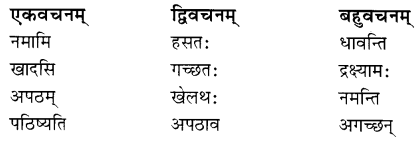
(ख) बालौ, देवताः, नराः, रामेण, बालकाभ्याम्, कविना, पशूनाम्, बालकयोः, बालकस्य, तौ, तस्मै , तेषाम्।
उत्तरम्-

